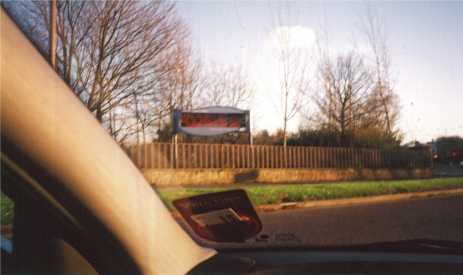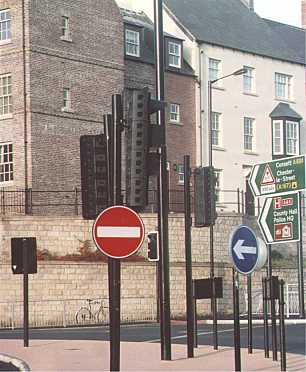The City of Durham Trust
“The Image of a County”
As a statutory consultee for many a District planning application, the County Authority is frequently decisive when an objection is submitted on grounds of highway safety. It was therefore an extreme surprise in the autumn when the County Authority gave itself permission for an "Announcement Facility" alongside the County Hall roundabout. The stated reason was to do away with occasional temporary banners attached to railings near to the entrance to County Hall, and instead "install a device more effective in communication and more suited to the image of a county authority."

Announcement facility - seen from car
Described as a variable message sign with LED illuminated lettering, such features are a common sight on motorway gantries. Here, on a five-junction roundabout, strict lane, and change of lane, discipline is imperative. The motto, "Making a difference where you live," is hardly a necessary message, and "Welcome to County Hall" is too late, since one’s vehicle has already been passed the entrance. These "fillers", however, pale in relation to notices which use all three lines of the facility to announce an event, together with dates and application details. (To add to the challenge, the illuminated letters fade as one is passing owing to their restricted angle of projection). Is it really possible to safely navigate one’s vehicle and at the same time comprehend the message? To Trustees, the Highway Authority’s approval appears incomprehensible.
Environmental clutter

Highgate, seen through part of 'polework' of new Millburngate roundabout
A comment often made in Trust writings is that small details can play a key role in influencing, for good or ill, appreciation of landscape or streetscape. It was therefore encouraging to learn in the autumn that both the Campaign to Protect Rural England and English Heritage announced programmes against environmental clutter. Attention was drawn to street furniture in general, but especially to the profusion of signs, multi-coloured tarmac and road markings, which are often duplicated, obtrusive and confusing, rather than simple and attractive yet functional.
English Heritage feels it necessary to produce a model streetscape manual for each region. CPRE suggests a "clutter audit" for every authority. Perhaps Trust members would like to compile their own audit. Two contrasting examples are offered here as a start. One is the redesigned roundabout at the end of Milburngate Bridge at the foot of Castle Chare. The traffic now moves more safely, but only after the erection of four dozen poles and signs. The other is the entry into Ushaw Moor from the east along Broom Lane. In a 300 metre section, in addition to the standard four 30mph and School pole signs, and between two yellow-painted bus stops, there is an endless succession of road markings: white ‘teeth’, yellow bars, white 30mph on red tarmac, another yellow bus stop marking, a triangular, multicoloured school sign, more yellow bars, a white slow and another white 30 mph.
